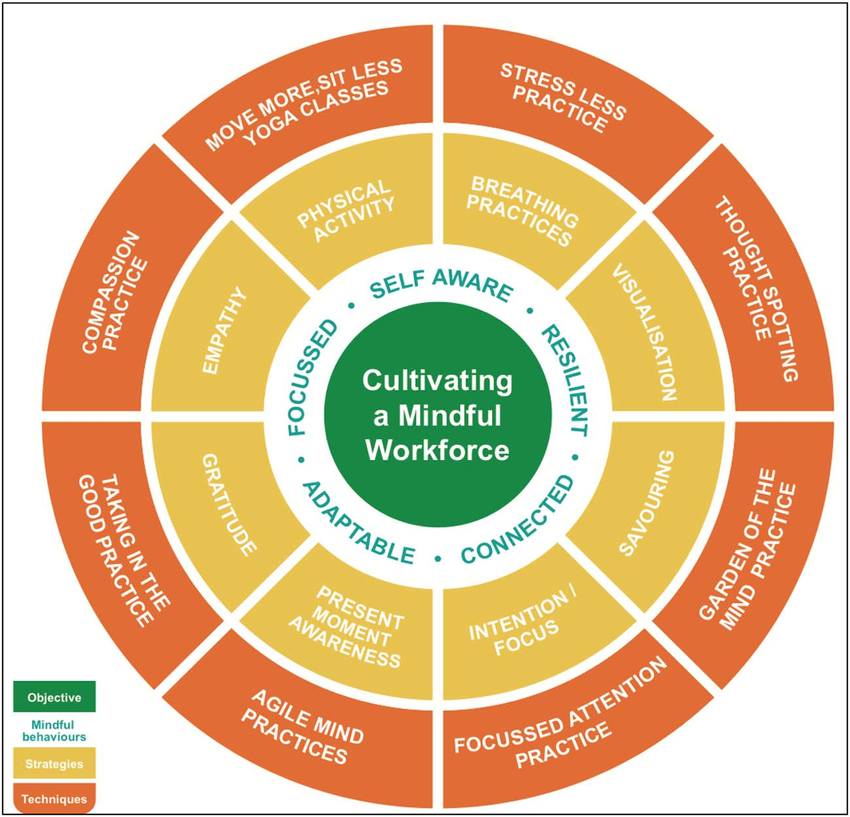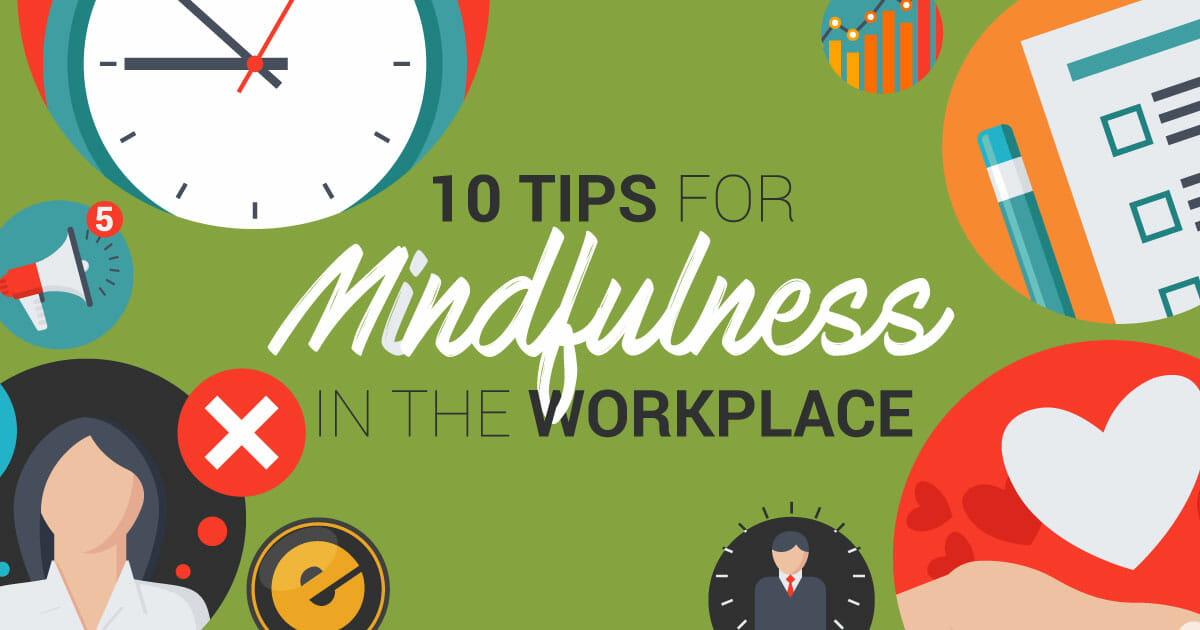In today’s fast-paced society, mindfulness is a buzzword that companies are implementing in their work environment. The purpose behind this initiative is to help employees stay focused and productive. In this blog post, we will discuss 10 tips for mindfulness in the workplace. You can use it to create a more mindful office space. Implementing mindfulness increases employee satisfaction, productivity, and creativity. Hence, this will invariably lead to increased revenue for your business!
Contents
What is Mindfulness in the Workplace?

Mindfulness is a state of active, open attention to the present. When you’re mindful, you carefully observe your thoughts and feelings without judging them good or bad. Mindfulness at work is when a person is fully into the task whatever he is doing.
Mindfulness in the workplace can help us be more focused and productive as well as less stressed, anxious, or exhausted. This allows us to build mental strength and emotional resilience. It is important to remember that mindfulness isn’t about trying to empty your mind of all thoughts. Rather it’s the quality of attention we bring to whatever we are doing.
Mindfulness can be cultivated through simple everyday activities. For instance, taking a few deep breaths before responding to an irate customer can help. Mindfully eating lunch, and going for a mindful walk at the end of your lunch break can also help.
Why is Mindfulness at the Workplace Important?
Mindfulness in the workplace is more essential than ever before as we shift from a manufacturing to a knowledge-based economy. The body was the main method of production in a manufacturing economy. In contrast, the brain is a necessity in the knowledge economy.
In a knowledge economy, employees are referred to as “capital assets”. Precisely, no one teaches those who manage others how to lead themselves. And no one teaches people how to change the most important tool in a knowledge economy, their own minds!
If a manager is unable to concentrate, it becomes a major issue. This is so because every bad emotion has an influence on decision-making. Mindfulness at work allows managers to free themselves from thoughts about the past and future and focus on the present. A leader with this skill can schedule meetings that occur in the present and let go of prior meetings. What about a yearly performance evaluation?
Employees become defensive as a result of this part of the brain that handles emotions. But what if managers began with one question, such as “How do you think this year has gone so far?”
Yes, there would be a learning curve. But, the employee’s brain activity would move to the brain that is linked to judgment, character, and ambition.
What about multitasking? Here is what the research says. In other words, when people cut down on their multi-tasking time. It is seen that both their productivity and quality of work improved significantly. In reality, they had a stronger relationship with coworkers, family, and friends. However, mindfulness training at work can have a far greater influence than simply altering listening.
Benefits of Mindfulness in Workplace

Hundreds of studies have shown that our brains can change at any time. These changes may be because of mindfulness. Studies have also found that the brain is changing for people who meditate about their conflicts.
Neurons grow in the brain that makes you aware. MRIs show other positive changes to your brain in eight weeks. Yes, this happens even if you do it for about 30 minutes every day.
Do people practice mindfulness in the workplace? Yes, they do. There are some efforts to teach more about it. Many companies have helped their employees learn how to be mindful while at work. Essentially, employees need to learn how to deal with the unknown. This must happen even before they know there is something they don’t know.
People who are mindful are often able to see how they are improving in their relationships with other people. But can practicing mindfulness help deal with difficult bosses? You can only control yourself, then it doesn’t pay to be angry at a boss no matter how difficult!
Difficult managers will always be difficult. However, when an employee practices mindfulness, they create an ability to relate to that manager with a much broader perception. The employee can respond with more discipline and with the ability to see things more clearly than others.
10 Ways to Practice Mindfulness

You can practice mindfulness in the workplace. Here are some ways:
Focus on your Breath

A simple breathing exercise may have a significant impact on your mental state. It’s one of the most unnoticeable ways to practice mindfulness at work. Take a minute to focus on your inhalation and exhalation. You feel yourself begin to relax whenever you start to feel anxious while working throughout the day. After a tiring day, it is the need of the hour to have a stress-free sleep. To have one, you must take short breaks in time and breathe. This helps you relieve stress. That is why you must focus on your relaxed breathing cycles.
Pick a Mantra
Don’t put it off until you get to your computer. Choose a good message or motto to start your day and repeat it to yourself throughout the day. “Peace begins with me,” is a powerful reminder that we are in control of our feelings and behaviors. The phrase “I’m ready” is an empowering one. The word “ready” can keep you cool and concentrated before a major presentation or meeting. Then come up with a slogan in the present tense to commemorate it.
Take Regular Breaks

Most people don’t think they have time to take a break, much less frequent ones. However, the 10% of employees who were the most productive in a study had a routine. Their work rhythm of 52 minutes of effort was followed by a 17-minute rest. According to experts, this is because the brain works at a higher level for around an hour. Then it starts switching to a lower level for a short amount of time. Therefore, it requires just the right length of time for a meditative break. Incorporate more frequent pauses into your routine. Set a timer on your phone to ring every hour.
Take a break whenever the timer goes off. It might be as little as one minute at your desk or as long as you can spare. Perform a simple mindfulness exercise such as a breathing exercise. It can also be a 20-minute meditation to release tension. Regular rest periods can be particularly beneficial and rejuvenating after lunch. It is when your mind begins to wear.
Check Email Less

Email can be a source of constant distraction. It can force you to devote your time to it rather than more important things. If possible, turn off your push notifications. Only check your email when you have quiet time to fully focus on it. Try to limit yourself to only reading what’s essential and ignoring the rest.
Actively Listen

Try paying attention to what others are saying during the day instead of simply nodding. You must wait for your turn to speak. You’ll profit from learning to quiet the internal noise in your head. You can create space and openness for you to comprehend what your coworkers are attempting to communicate with you. You may also improve your interactions at work by being more present and mindful during them. Be adaptable. It’s easy to get stuck in a routine at work, but mindfulness can help you become more adaptable and flexible. You will feel better as well as equipped for change whenever it inevitably happens. In fact, mindfulness reduces feelings of depression. This depression may result from external factors such as changes at work or moving home.
Practice Gratitude
Everyone has bad days at work, and the key is to use them as a chance to be more mindful. Try a gratitude meditation the next time you’re feeling down at work. Write down one or two things you appreciate about your job. This is an excellent method of taking notice of and developing an appreciation for your profession. Take care of yourself. It’s important to practice mindfulness at work by taking time for self-care. It includes getting enough sleep and exercises every day. Also, it comprises eating well and practicing good hygiene. It is also about spending quality time with friends or family members each week. At last, it is about carving out some quiet “me” time.
Use Your Commute to Mindfully Unwind
Set limits to enable you to be truly present at home. It’s crucial to disconnect at the end of the day and establish boundaries. You may really be present at home. The commute might be a good opportunity for this transition. Here’s one approach to make it happen. Turning off your phone, radio, audiobook, and any other distractions that might pull you into your work. Try to pay attention to your surroundings and the sensations of driving. It can be an opportunity for mindfulness practice in its own right.
Cultivate Humility
Humility derives from the Latin humilis, which means “lowly”. It is a state of humility in which people do not feel compelled to constantly remind others of their accomplishments. Humility may seem at odds with our culture’s emphasis on boasting about oneself. However, it is actually attractive—no one wants to be around individuals who constantly brag about themselves.
How is humility connected to mindfulness? Mindfulness entails accepting oneself just as one is and being open to others’ opinions. Gratitude is also a term associated with mindfulness—you are aware of the assistance you have received. Someone who values other people’s input will be naturally modest. Try the following to increase your humility:
Make a Conscious Effort to Move Your Body
Mindfulness reduces activity in the part of the brain that generates our self-narrative, sometimes known as the narrative self. It’s unhealthy to devote too much time to yourself and your own story. Mindfulness meditation allows you to be more aware of your senses -the current self. Your attention expands beyond the limits of your own mind and body.
Accept What You Can’t Change
Acceptance is at the heart of mindfulness. To be aware means to embrace exactly what is happening right now. It also implies acknowledging your current state and accepting yourself as you are. It does not imply giving up or surrendering. However, it does imply recognizing the fundamental reality of how things stand right now before attempting to alter anything.
Acceptance is also more powerful. Self-acceptance entails accepting all sides of yourself—including your flaws, shortcomings, and aspects you don’t like—as well as those you respect. You’ll save a lot of time criticizing yourself when you accept yourself. You’ll be much better able to appreciate your triumphs. You will laugh at your faults if you accept yourself.
Those with a fixed mindset think that their intelligence and talents are unchangeable qualities. They prefer to spend their time hoping that their characteristics will lead to success. The people there don’t strive to improve because they believe that talent alone brings about success. They turn out to be incorrect—brain research has shown otherwise.
People with a development attitude believe that they can enhance their intellect and talents through hard work. They believe that by putting forth an effort, they will improve. They consider brains and talent to be only the beginning; rather than building on them, they strive for greater success. Effort does seem to result in increased intelligence and improvement of basic talent over time.
Conclusion
Mindfulness is all about adopting a development mentality. Mindfulness is about paying attention to the present moment. It is not evaluating your natural ability or intelligence but being receptive to new possibilities. You don’t mind getting negative feedback when you have a growth mindset because it’s an opportunity to learn something new. You don’t mind assuming additional responsibilities because you’re interested in seeing how you’ll perform. Expecting challenges as a path to personal growth is the central theme of mindfulness in the workplace. That’s what mindfulness at work is all about. Believe that you can progress and develop with time. Approach problems boldly. Live in the present. Learn new things about yourself and others.
Do you want to keep your employees happy, healthy, and productive? Join our employee assistance program and get a healthier workplace.


